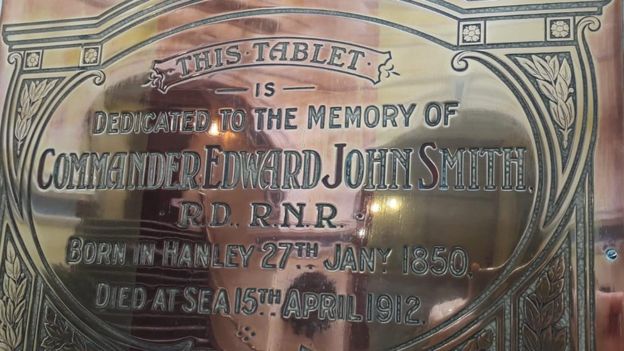 |
| ‘Stern View, Titanic’ from the famous Father Browne Collection of Titanic images. Taken while the ship is anchored at the entrance to Cork harbour, passengers can be seen relaxing on the after deck. A closer inspection of the after funnel reveals the image of a man’s head taking advantage of the spectacular views from his lofty position above the ship. Three and a half days after this nostalgic image was snapped, many of those passengers would have witnessed great tragedy and many would have been lost in the icy waters of the North Atlantic.
Titanic's captain, Edward John Smith, was born in Well Street in Hanley in 1850. The son of a pottery presser and a grocer, Smith attended Etruria British School before starting work at age 12 at the Etruria Forge, where he operated a steam hammer.
A few years later, he went to Liverpool to follow in the footsteps of his half-brother Joseph, who was in the Merchant Navy, and was apprenticed as an ordinary sailor. By the age of 25 he had passed his master's certificate of competency to command a vessel and by 1880 had joined the White Star Line where he rose through the ranks to captain some of the biggest ships of the day.
He married Sarah Eleanor Pennington, a farmer's daughter, in 1887, and their only child, Helen Melville Smith, was born in 1898.
Smith told a New York Times reporter in 1907 he had "never experienced any problems at sea". That same year, White Star revealed plans to build three new ships - the Olympic, the Titanic and the Gigantic. The Olympic went into service in 1911 and was captained by Smith, who now held the rank of commander.
By this point, he had become known as the "millionaire's captain", the number one choice for the aristocrats of the time - many of whom chose to sail with him because of his reputation for safety and affability.

In April 1912, while the Olympic was in for repairs, he took command of the supposedly "unsinkable" RMS Titanic for its maiden transatlantic voyage from Southampton to New York. When it departed, the ship was carrying 885 crew members and 1,316 passengers.
Smith was awoken about 20 minutes before midnight on 14 April after the ship hit an iceberg.
The liner sank less than three hours later at about 02:20. About 1,500 people perished, including Smith who went down with his ship.
A number of different accounts emerged about what the captain's last movements were, with one version that he dived into the sea as the bridge of the ship went under.
The British inquiry into what happened found that Smith had ordered the ship to travel too fast and that the lifeboats had not been filled before being lowered, but it was made clear that "negligence cannot be said to have had any part".
Smith's portrait was hung in his former school in 1913 and later a plaque was installed in Hanley Town Hall, while a further plaque was installed at his former home in 2012 to mark 100 years since the ship's sinking.
A bronze statue of him stands in Lichfield's Beacon Park in south Staffordshire.
Acknowledgement: www.bbc.com/news/uk-england-stoke-staffordshire-49841730
..........................................
|
| Ancestry: The Titanic Collection for Family Historians Halifax, Nova Scotia, Canada, RMS Titanic Fatality Reports, 1912 Halifax, Nova Scotia, Canada, RMS Titanic Graves, 1912 Titanic Survivors, Carpathia Passenger List, 1912 UK, RMS Titanic, Crew Records, 1912 UK, RMS Titanic, Deaths at Sea, 1912 UK, RMS Titanic, Outward Passenger List, 1912 molegenealogy.blogspot.co.za/2012/04/titanic-records-online.html |
No comments:
Post a Comment